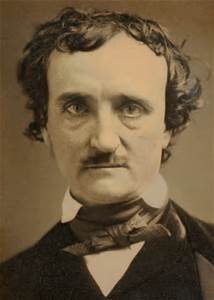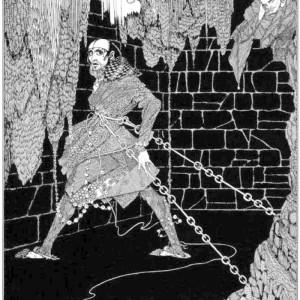If Edgar Allan Poe—and his writing—has not aged well and seems more than a little passé for 21st century sensibilities, it’s not entirely his fault. Like others who have done things first, and best, it’s likely we grow more impatient with their imitations than the original.
In any event, Poe was a pioneer in almost too many ways to count. If his work and his life (and most especially his death) seem clichéd, dying young, debauched and with too little money was not yet the career move it would eventually become for other artists. With vices and an intensity that would give even a young Charles Bukowski pause, and would have buried the punk rock poseur Sid Vicious, Poe managed to be for literature what Miles Davis was for jazz: he didn’t merely set new standards, he changed the course of subsequent art, perfecting entirely new paradigms in the process.
Some might claim Poe gets too much credit for perfecting (if not inventing) the American short horror story and detective story. The fact is, he doesn’t get enough.
Perhaps the best way to gain historical perspective on the proper scope of Poe’s achievements and influence is to consider an abbreviated list of legends who stood on his doleful shoulders: French poet Charles Baudelaire (who both championed and translated Poe), H.G. Wells, Jules Verne, Robert Louis Stevenson, Herman Melville, Arthur Conan Doyle, William Faulkner, Flannery O’Connor and a trio of tolerably impressive non-Americans: Fyodor Dostoyevsky, Oscar Wilde and Sigmund Freud. Suffice it to say, if your work has any part in shaping or inspiring authors who make significant contributions to the canon, your status is more than secure.
Arguably, no American figure has influenced as many brilliant—and imitated—writers as Poe. The entire genres of horror, science fiction and detective story might be quite different, and not for the better, without Poe’s example. More, his insights into psychology, both as narrative device and metaphysical exercise, are considerable; he was describing behavior and phenomena that would become the stuff of textbooks several decades after his death.
He also happened to be a first rate critic, and his insights are as astute and insightful as anything being offered in the mid-19th Century (his essay “The Poetic Principle” comes as close to a “how to” manual for aspiring writers as Orwell’s justly celebrated “Politics and the English Language”). Oh, and he was a pretty good poet, too.
When assessing Poe, 150-plus years after he died, it’s imperative to interrogate and untangle that fact that not all clichés are created equally. Or, put another way, we must remember that before certain things became clichés, they were unarticulated concerns and compulsions.
When we talk about old school we typically call to mind an era that was pre-TV and even pre-movie. Well, Poe was writing in an era that was pre-radio and practically pre-daguerreotype. With no Snopes or MythBusters, encyclopedias not readily available and religion the common if inconsistent arbiter of moral guidance, Poe was not after cheap frights so much as uncovering the collective unconscious. Put more plainly, this was a time when being accidentally buried alive was something that could conceivably occur.
The reason Poe remains so convincing and unsettling is because he doesn’t rely on goblins or scenarios that oblige the suspension of belief; he is himself the madman, the stalker, the outcast, the detective and, above all, the artist who made his life’s work a deeper than healthy dive into the messy engine of human foibles, obsessions and misdeeds. He stands alone, still, at the top of a darkened lighthouse, unable to promise a happy ending and half-insane from what he’s seen.
Here we celebrate Poe’s ten greatest tales, but first, a brief sample of tales that don’t quite make the cut, but warrant attention and approbation.
First and foremost, the almost unclassifiable (and Poe’s only novel-length work) “The Narrative of Arthur Gordon Pym of Nantucket”. Jorge Luis Borges loved it, Jules Verne was undoubtedly influenced and without this model, we may not have gotten our great (white) American novel. If it’s good enough for Melville, it’s good enough for everyone.
“Berenice” and “Eleonora”, two character studies of doomed women, both epitomizing some of Poe’s most persistent fixations (teeth, premature burial). There’s also the whole “cousin thing”.
The type of story O. Henry would make a career of, “The Oval Portrait” is an early “shocker” even though contemporary audiences will see the conclusion coming a mile away. Like “Pym”, this one makes the cut if only for the eventual masterpiece it influenced, in this case Wilde’s The Picture of Dorian Gray.
It might be a stretch to say that “Hop-Frog” presaged all the slasher dramas of the ‘70s and ‘80s, but it’s definitely a quite satisfying prototype of the abused outcast getting his revenge, equal parts Michael Myers and (Black Sabbath’s) Iron Man—with grating teeth.
Finally, “A Descent into the Maelström” is rightly credited as being an early attempt at a proper science fiction study, and the technique of an older, wiser sailor recounting his tale as narrative is an obvious antecedent to Conrad.
10. “The Gold Bug”
You almost have to transport yourself back to a time without electricity to fully appreciate Poe’s achievement here. In terms of influence, Robert Louis Stevenson merrily declared he “broke into the gallery of Mr. Poe” (for the creation of Treasure Island), and the bug bite instigating heightened awareness anticipates both “Spiderman” and “The Fly”. The extensive use of ciphers—cryptography being a big fad of the time—also may have inspired Zodiac (the killer and the subsequent movie). Even the appallingly dated dialect of Jupiter is a prelude for the cruder moments of The Adventures of Huckleberry Finn.
The sheer effort of imagination alone in seeing this one through requires that it be regarded as an important work.
9. “The Facts in the Case of M. Valdemar”
Another one that must be properly appraised as a product of its time, the fact is that, upon publication, this tale caused a public uproar because it was sufficiently believable. This tale employs the ostensibly scientific case study of a hypnotized patient who, in his mesmerized state, is able to exist in a surreal, inexplicable condition where he’s dead but… still alive. Once again, as preposterous as this sounds, today, and as outlandish as it clearly was, even in 1845, it’s a credit to Poe’s masterful description, pacing and use of suspense that he actually pulled it off.
8. “The Murders in the Rue Morgue”
Celebrated as the first modern detective story, Poe’s hero C. Auguste Dupin is featured in two subsequent tales, “The Mystery of Marie Roget” and “The Purloined Letter”, but “Rue Morgue” is the most famous, and best of the three. One of the many Poe efforts made into an inferior, and terribly dated, film, it works best on the page. Using his powers of deliberation, Dupin is an undeniable model for Doyle’s Sherlock Holmes. Poe is in full command of his considerable powers here, employing the process of investigation and discovery, cleverly employed humor and terror, and a character who proves he’s smarter than everyone else.
7. “William Wilson”
It seems impossible to prove that Dostoyevsky was directly influenced by Poe, but it’s difficult to believe early novel The Double was not in some way informed by this compact tale that manages to invoke class, the concept of the doppelgänger, split-personality and the self-corrective of one’s conscience (all themes Dostoyevsky would make his calling card, culminating in his masterpiece The Brothers Karamazov).
In only a handful of other stories was Poe so deftly able to balance shock and humor, albeit of a very dark variety. Cognizant that the narrator is a scoundrel, it’s difficult to pity his plight even as we shudder at the humiliation he suffers. Although not often described as such, “William Wilson” is a tour de force psychological case study of an unreliable narrator tortured by a deservedly conflicted sense of self.
6. “The Pit and the Pendulum”
Darkness. Torture. Rats. Any questions? How about a slowly descending, foot-long razor ever-so-slowly descending from the ceiling, giving you plenty of time to think about how it will eventually (and ever-so-slowly) slice open down the middle? And that’s just a basic summary.
Here is a one of Poe’s most fully realized attempts at “totality”. Poe creates a complete atmosphere of terror, where the narrator and reader understands it’s not random, his captors are very aware of the conditions they’ve created, making the tension difficult to endure. Where other stories describe, in often excruciating detail, the anguish inflicted on an overly sensitive individual, in this one Poe makes the reader acutely aware of their own senses: unable to see inside the pit, smelling the rats as they gnaw at the ropes, hearing the deliberate hiss of the pendulum, feeling the sweat frozen by the fear of death.
5. “The Tell-Tale Heart”
Another one that’s easy to imagine Dostoyevsky studying, this time in the construction of his underground man (Notes from Underground): an unreliable narrator, or a narrator so reliable – -and truthful—that he indicts himself in the attempt to be understood, and pitied. As a study of horror, “The Tell-Tale Heart”, perhaps Poe’s most (in)famous story, seems tame to contemporary audiences. But as an examination of obsession and psychosis?
An amazingly compressed rendering of a pathology pushed to irrational extremes, Poe laid the groundwork for everyone from Fantômas to Norman Bates. The real fear an adult can derive from this story is not the narrator’s brutality or even innocence, but his insistence that he’s sane.
With understated irony, Poe decodes the self-deceived stratagem of our most dangerous sociopaths.
4. “The Masque of the Red Death”
Although if only considered an unrivaled allegory of death (and its inevitability), that somewhat superficial analysis still sells this one short as a blistering critique of social stratification. Here Poe uses a rampant disease to illustrate not only the behaviors but attitudes of the haves toward the have-nots: actively walling themselves inside a fortified castle while misery wipes out the countryside, the superbly named Prince Prospero and his court can’t be bothered with empathy for the afflicted, they have lavish masquerade balls to attend.
A masterful clinic of the Gothic aesthetic ensues as different-colored rooms are described, the air of revelry undercut with hourly reminders of mortality, courtesy of the ebony clock. Finally, there’s the spectacle of a silent intruder who mockingly moves from room to room, until finally confronted by the unfortunate prince.
And then, comeuppance courtesy of one of the great closing lines in literary history: “And Darkness and Decay and the Red Death held illimitable dominion over all.”
3. “The Black Cat”
Self-loathing? Poe, at times, makes the Grunge and Goth movements look like an ecstasy-addled rave. His irredeemable spiritual desolation was rooted not in anything like the info-overload pressure of too many choices we confront today, or finding the perfect partner or job, but fear of poverty, hunger and the unremarkable ailments that preyed upon humanity for so many centuries before sufficient medical advancements were made. He lived in a time when even libraries might not have the information you needed, so you wrote it down or took to sea or went insane as a matter of principle.
In “The Black Cat”, when the narrator’s abuse of the bottle becomes unmanageable, it seems not autobiographical so much as an expression of the author’s greatest fear: that his appetite for alcohol would poison his personality and override his ability to create. It’s also Poe’s first extended interrogation of PERVERSENESS (all caps here, just like the story), which is described as an “unfathomable longing of the soul to vex itself—to offer violence to its own nature.” The image of the corrupted narrator, hanging his beloved cat with tears streaming down his cheeks, remains among the most pitiful, and genuinely haunting images in the Poe catalog.
Once more, it’s tantalizing to contemplate the ways Dostoyevsky may well have been developing the possibilities of an irresistible perversity driving one to self-defeat (which Poe himself expanded upon in “The Imp of the Perverse”) in both The Double and Crime and Punishment. “The Black Cat”, while quite successful as a spooky tale with an outrageous ending, presents Poe the psychologist at his most incisive—and unsettling.
2. “The Fall of the House of Usher”
If “The Masque of the Red Death” features one of the all-time great closing lines, “The Fall of the House of Usher” contains one of the most sublime opening passages: in one extended paragraph containing 417 words, Poe provides an enduring showcase for his “unity of effect” theory. Practically every image, every action, every word is dedicated toward the invocation of dread, and the suspense careens toward a conclusion that is literally shattering (in several senses of the word).
The tale concerns itself with the narrator and his childhood friend, Roderick Usher, as well as his twin sister Madeline. And yet the main character is the house itself. The narrator feels a palpable sense of dreariness and decay as he approaches the family mansion, a foreboding that comes full circle as the house collapses into itself in the final scene.
It’s the effect the house has on its tenants, however, where Poe couples supernatural suspense with a human frailty to devastating effect. Sensitive to the point of intolerance to sound, Roderick has become an imploding specter of nervous energy and despair. As he confesses to his friend, “I feel that the period will sooner or later arrive when I must abandon life and reason together, in some struggle with the grim phantasm, FEAR.”
With astonishing economy (this story could—and likely would, by a lesser writer—have easily been stretched into a novel, albeit with lesser impact and effect), Poe manages to invoke his enduring preoccupation of live burial, split personalities, ruminate on the sentience of inanimate objects, and complicate the notions of art imitating life and vice versa, all while steadily orchestrating the ultimate confrontation (twin vs. twin, brother vs. sister, human vs. house, life vs. death). Tragic and absurd as the events become, the narrator is content to leave it as a family matter, hastily escaping as the history of the house and its occupants sink into nothingness.
1. “The Cask of Amontillado”
We’ve discussed a perfect opening section and a perfect closing sentence; “The Cask of Amontillado” is just perfection, period. It represents the consummation of so many of Poe’s aesthetic innovations, crafted so each sentence builds upon the next (like an expertly tiered stone wall…), amping up the humor, irony and, finally, horror. Not a word wasted, an image unnecessary, a line of dialogue inessential and yet, despite the formal symmetry at its heart, a mystery.
What is the insult that drives Montresor’s homicidal rage? It’s never clear, and that only adds an element of menace. Is Montresor, like many of Poe’s most inscrutable murderers, more or less insane? Put another way, it’s difficult to fathom, since he and Fortunato are still at least superficially cordial, any offense that would warrant live entombment.
As with “The Masque of the Red Death”, Poe nimbly operates on multiple levels: there’s an element of class disparity and resentment seething within the dialogue. When Montresor insists that he is, in fact, a mason (one of the delightful ironies, as he pulls out his trowel), it’s easy to overlook Fortunato’s offensive disbelief (“You? Impossible! A mason?”).
There’s also the not inconsiderable matter of Montresor’s family crest, wherein “the foot crushes a serpent rampant whose fangs are imbedded in the heel.” It’s simple to imagine Montresor is the foot smiting the serpent, but it’s possibly more appropriate to consider Montresor as the snake, refusing to die or, if he’s to be defeated, fighting to the death. The motto “Nemo Me Impune Lacessit” (You will not harm me with impunity”) is at once appropriate for his character, yet repugnant.
A writer has succeeded if, in creating a story, a single unforgettable image is imprinted within the reader’s mind. How many such scenes exist in this one short tale? The image of a drunken Fortunato (that name!), in motley—playing the clown, being played for a clown—insistent on proving his expertise, as he’s drawn deeper into the catacombs; the aforementioned passage concerning whether Montresor is, in fact, a mason (producing the trowel, one of the great incidents of foreshadowing in fiction); Montresor, the mason, hurriedly piling brick upon brick; Fortunato, finally comprehending his plight, screaming inside the depths of his crypt, only to have Montresor, full of malevolent confidence, screaming back at him (no one will hear us down here, my friend).
And finally, the most cold-blooded line in Poe’s collected works: “My heart grew sick—on account of the dampness of the catacombs.” Is it, finally, the pang of human remorse? Or is it one last twist of the trowel, one final act of impunity to repay the insult made more than 50 years before? Like the insult itself, we’ll never know.
*Originally published at PopMatters on 10/29/15.



